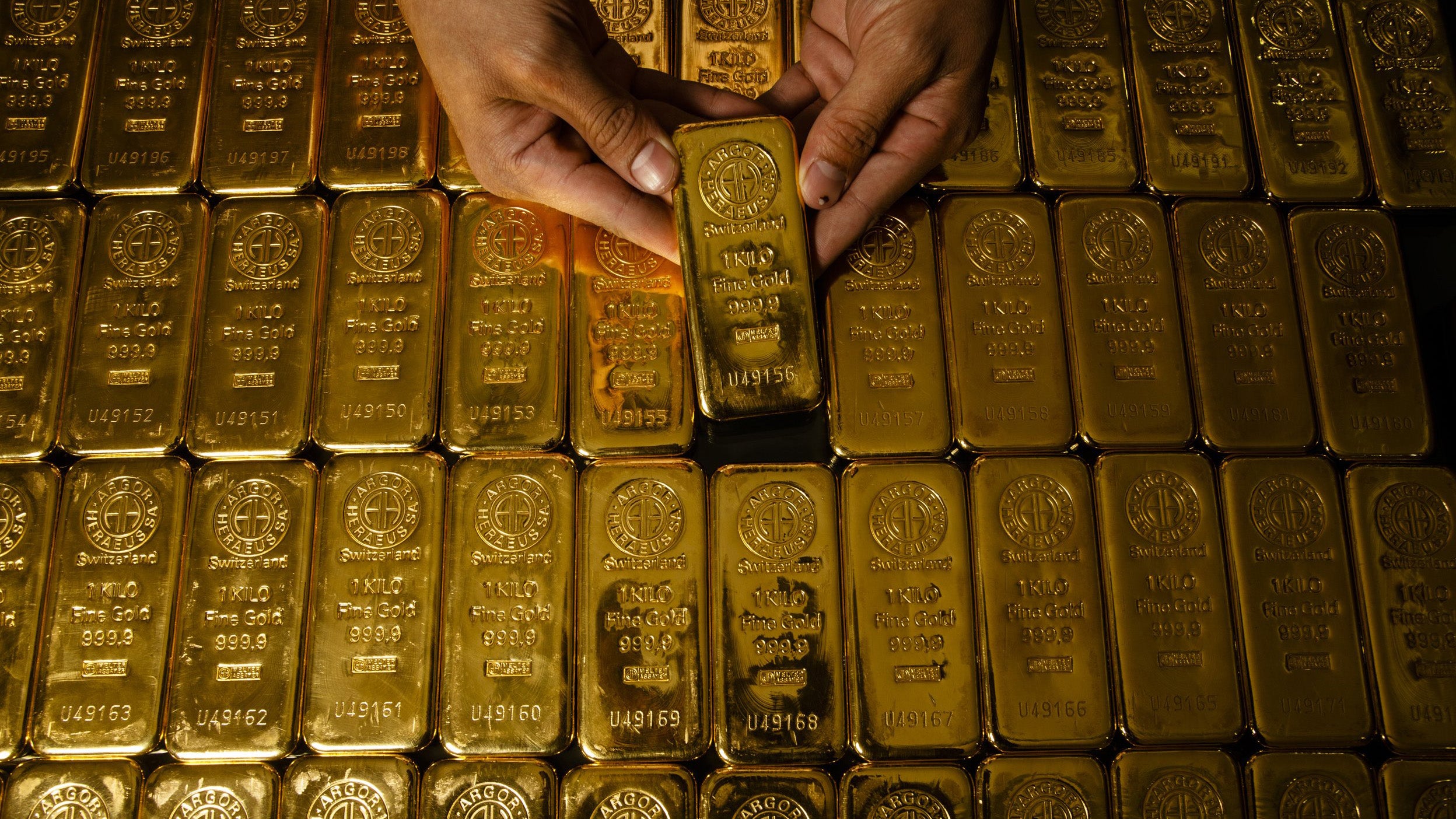
ETF Getting more out of your cash allocation
Discover alternative cash management solutions that may be able to offer enhanced returns versus overnight deposit rates.

The gold price has been setting new highs as interest rates have fallen, economic and political conditions have become more uncertain, and investors have been buying
Historically, gold has been a source of long-term value and provided a potential “cushion” against the adverse effects from stock market volatility, uncertainty and inflation
Physical gold exchange-traded products offer an easy and cost-effective way for investors who want to gain exposure to gold
Investment risks
The value of investments, and any income from them, will fluctuate. This may partly be the result of changes in exchange rates. Investors may not get back the full amount invested. For investors in our gold exchange-traded product, if the issuer cannot pay the specified return, the proceeds from the sale of the precious metal will be used to repay investors. Investors will have no claim on the other assets of the issuer. Instruments providing exposure to commodities are generally considered to be high risk which means there is a greater risk of large fluctuations in the value of the instrument.
Gold has been treasured by people across the globe for thousands of years. It’s been used as currency and for bartering, as a symbol of wealth, and more recently for its investment characteristics. In this article, we’ll answer some of the most common questions we hear from investors. What’s driving the gold price? Does gold offer any protection and, if so, against what? Is it potentially suitable for investors with environmental or social concerns, and how can investors use it in their portfolio?
Today, gold is held by different types of investors for a variety of reasons. For example, wealth managers may use it to help cushion losses in their client portfolios if stock markets fall. Individuals might want to invest in gold if they’re looking for physical assets that may be able to retain their value over the long term even after inflation. And while central banks are not really investors, they often hold gold as part of their reserves, alongside other assets including foreign currency and government-issued securities such as US Treasury bonds. Central banks hold these assets to help them manage liquidity in the financial system and the economy especially in times of crisis.
Gold held by retail and institutional investors has increased substantially in recent decades, due largely to gold-backed exchange-traded products (ETPs) making it easier for them to gain exposure.
Source: Bloomberg, as at 30 April 2025. This chart shows the total quantity of gold held (in millions of ounces) by gold-backed exchange-traded products across the world.
Gold has been the best performing asset so far in 2025, just as it was in 2024 when it even outpaced the returns from US equities. The gold price reached an all-time high of US$3,500 per ounce in April, but by then some analysts had already been increasing their end-of-year price predictions. Of course, nobody can predict the future with any certainty, but we can comment on recent activity and try to explain what we believe has been behind the phenomenal rise in this precious metal.
What makes gold so interesting from an investment perspective is that its price can be influenced by a variety of factors. Some of these are based on macro-economic principles and others are more psychological. Gold’s rise in recent years has been partly driven by central banks. Those in developed markets have been cutting their short-term interest rates, which tends to be positive for gold, while those in emerging markets have been major buyers of gold, making this sector a key source of demand for the precious metal. Overall, central banks have purchased gold for their reserves in every calendar quarter but one for more than 10 years.
The inflation picture has also supported gold. Lower inflation expectations have helped push down medium-term bond yields, which reduces the opportunity cost of holding gold. Let’s explain. Because gold does not pay any income, it is less attractive when investors are able to get a high income from other assets that are considered to have lower risks, such as government-issued bonds. Conversely, when bond yields go down, gold becomes more attractive.
The relative value of the US Dollar can often have a material effect on the gold price. After the USD strengthened in the second half of 2024, it has weakened considerably in 2025, which has made gold less expensive for non-USD investors and other consumers. This was the case for European investors recently when the EUR rose to its strongest level versus the USD in over three years.
The psychological influences are linked to the perceptions that, in volatile times, gold tends to be relatively stable compared to equities and other risky assets and is often sought-after during periods of heightened fear and uncertainty. Central banks especially in emerging markets have been buying gold to diversify their balance sheets away from USD assets while also helping them manage geopolitical and economic risks. Other investors have also been buying gold, whether directly through the purchase of gold coins and small bars, or via physical gold ETPs.
The gold price over the past year has also been driven by increased geopolitical and economic uncertainty as well as stock market volatility. More accurately, the price has been driven largely by investors buying gold because of these increased risks and volatility. If we look at the physical gold ETP market for the past five years, we can see that investor demand was strongest during two distinct periods: in the first months of the pandemic and when Russia invaded Ukraine. In both cases, there was a high amount of uncertainty and heightened volatility.
It’s important to highlight that gold doesn’t provide any actual “protection” in the sense that there are no guarantees. As with other investments, the price of gold can go down as well as up, and investors may not get back the amount invested.
Historical evidence suggests that gold has often been able to provide a “cushion” against the downside risks that uncertainty and volatility can inflict on an equity portfolio. Gold has also tended to hold up during sudden rises in inflation or during periods of “stagflation”, which is a scenario whereby an economy suffers high inflation, high unemployment and low growth all at the same time.
Over the past 50 years, gold is one of the only asset classes that has demonstrated the tendency to move in the same direction as both the level of inflation and the change in inflation. In other words, the gold price has tended to rise when inflation is both higher than normal and rising.
For illustrative purposes only. Source: Bloomberg, ICE, Invesco, as at 31 Dec 2024 based on calendar year data, 1978-2024 (except Global Agg which uses 1990-2024). “Core CPI” refers to US core inflation. All asset returns are core CPI-adjusted and are in total return format, unless stated otherwise: Cash uses the ICE BofA US 3-month Treasury Bill index, US Treasuries uses the Bloomberg US Treasury Index, Global Agg uses the Bloomberg Global Agg Index, USD investment Grade Credit uses the Bloomberg US Corporate Bond Index, Commodities uses the S&P GSCI Total Return Index and Gold spot price per ounce. Past performance does not predict future returns.
The gold mining and refining industries are focused on improving sustainability, accountability and transparency. The goal is to provide investors and consumers with more clarity and confidence that the gold they are buying has been sourced and processed according to a high set of standards. The World Gold Council launched the Conflict-Free Gold Standard (CFGS) in 2012, putting in place processes for mining companies to guard against the risk that gold would be used to fund or support unlawful armed conflict. The CFGS has now been incorporated in the Council’s more comprehensive Responsible Gold Mining Principles, issued in 2019, for its 32 member firms (mining companies). This framework establishes what constitutes responsible gold mining.
Likewise, the London Bullion Market Association (LBMA) has a mandatory Responsible Sourcing programme for any refiner wanting to trade with the London Bullion market. The LBMA issued its Responsible Gold Guidance in 2012 and has updated the document multiple times since then to incorporate incrementally improving guidelines and auditing guidance around relevant issues. They continue working with mining companies to develop best practices across the industry.
The World Gold Council and LBMA have been issuing separate guidance to their members since 2012 and are now working together on a combined framework, trialling a blockchain solution for tracking gold from the mine all the way through the supply chain.
Mining is an energy-intensive process that often impacts the local ecology and, while it may never be totally environmentally neutral, improvements can be made to reduce the negative impact. At Invesco, these environmental issues are generally high on our agenda when we engage with the senior management of the mining companies in which we have equity holdings. We seek to better understand their views, steps they are taking to mitigate risks and reduce their carbon footprint.
Mining companies must also have plans for restoring the ecology at the end of the mine’s lifetime. Ethics extend beyond the environment, of course, and mining companies can make a positive impact on addressing socio-economic issues. Given that a productive mine may be in operation for many decades, mining companies will often help develop local housing, transportation, schools and medical infrastructure. This can have long-term material benefits for emerging economies.
While much of gold’s value is linked to its investment characteristics and cultural significance in major jewellery markets such as India and China, the precious metal’s physical properties also make it valuable for use in a range of high-end technology applications including from the medical and aerospace industries.
Total demand from this sector accounts for just under 10% of annual gold demand, but the amount used has been fairly steady over the past decade, according to data published by the World Gold Council. The electronics sector consumes around 80% of this demand, with gold a critical element in the manufacture of semiconductor chips. In health care, gold nanoparticles are used in many of the diagnostic testing kits such as those relied on throughout the covid pandemic.
Some investors may add a holding in gold for the same reason they invest in other assets, because they believe the price may rise. This speculation may be driven by the belief that central banks will continue buying gold, or investor interest will increase, or any other factor of supply and demand.
Probably a more likely reason is that investors want to diversify their portfolios or provide a possible cushion against losses in case of rising inflation, stock market volatility, economic uncertainty or geopolitical risks. Although gold offers no guarantees and can go down even when you expect it to behave differently, historically it has tended to hold up well during sharp equity market downturns.
Gold can be a useful tool for diversification because its price tends to move differently from most of the other assets in a typical portfolio. Historical evidence shows that the gold price often behaves independently from equities in particular but also bonds to a lesser extent and even a broad basket of commodities. This characteristic means gold can potentially act as a ‘cushion’ for the rest of the portfolio when other assets are falling in price.
|
Gold |
BCOM |
MSCI World |
S&P 500 |
Global Agg |
US Treasuries |
|---|---|---|---|---|---|---|
Gold |
1.00 |
|
|
|
|
|
BCOM |
0.32 |
1.00 |
|
|
|
|
MSCI World |
0.12 |
0.43 |
1.00 |
|
|
|
S&P 500 |
0.02 |
0.31 |
0.91 |
1.00 |
|
|
Global Agg |
0.42 |
0.14 |
0.12 |
-0.03 |
1.00 |
|
US Treasuries |
0.12 |
-0.16 |
-0.26 |
-0.28 |
0.60 |
1.00 |
Sources: Invesco, Bloomberg, as at 28 February 2025. Correlations are based on weekly returns over the past 20 years. All benchmarks in USD. Past performance does not predict future returns.
Discover how to gain exposure to the gold price through one of the largest and lowest-cost gold exchange-traded products in Europe.

Discover alternative cash management solutions that may be able to offer enhanced returns versus overnight deposit rates.

Investing in digital assets is now easier than ever with Bitcoin ETPs becoming more accessible globally. Learn more about the rise of bitcoin and why it matters now.

October posted the second-highest flows after September’s record, with US equities surging and fixed income ETFs hitting an all-time high.